Medcalf and Vartan resurrect their set for last year’s Die Walk¸re
at the start and present us with a colonnaded state-room over-looked by a
balcony approached by two graciously curving stairways, the sombre gravitas
of slate-grey alleviated by the proud red, white and blue of six Stars and
Stripes. Vicenzo Costanzo’s Riccardo makes an imposing entrance and takes
his place at a central lectern to hear the petitions of his people,
acceding to their pleas with patrician benevolence.
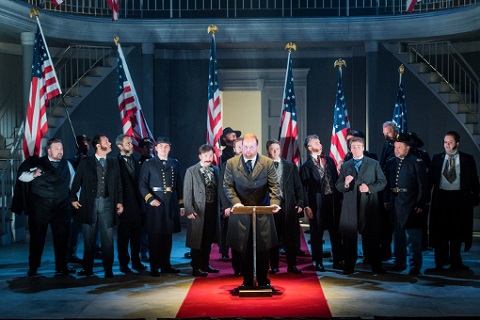 Roland Wood (Renato – centre) and GPO Chorus. Photo credit: Robert Workman.
Roland Wood (Renato – centre) and GPO Chorus. Photo credit: Robert Workman.
Although the Riccardo of the libretto possesses little of this stateliness
and stature, it’s a credible setting which allows Medcalf to juxtapose
loyalty and treachery in the form of, respectively, the Bostonian populace
and Riccardo’s arch enemies, Sam and Tom, who are plotting his downfall.
The problem is that it serves less effectively for the subsequent locales.
The transition to the fortune-teller’s Ulrica’s hut is slickly effected, as
David Plater’s lighting translates us to a scene of nocturnal witchery and
the hut slides to the centre of the state room, but the subsequent gothic
ghoulishness – top-hatted skulls perched crookedly on Ulrica’s ‘altar’; she
decapitates a chicken and smears her hand-maidens with its blood; flames
shoot violently from the roof of her hut – seems out of place within the
realist frame of state office. When the women start twitching and writhing
hysterically it’s as if the confessions of Miller’s The Crucible
are taking place in the White House.
Realism and romance further collide when Riccardo enters, disguised as a
sailor, and utilises a skull as a ventriloquist’s dummy when begging Ulrica
to tell him his fortune – though perhaps it’s a fitting symbol for the
fatal future she reveals: that he will die soon, slain by a friend.
The scene of Amelia’s gallows-tree tryst is similarly awkward scenically.
In Rigoletto, though the eponymous jester ignores the fatal shadow
that hangs over him, we are intermittently reminded of Monterone’s
curse by Verdi’s spine-tingling motivic repetitions of the parole sceniche. Riccardo is similarly blasÈ about his fate, but
here symbols of death are more prevalent. As Amelia searches (on the
balcony?) for the herbs which will cure her of her forbidden desire, nooses
fall from the ceiling, dangling provocatively through the lovers’
declarations of love and their subsequent interruption by Amelia’s husband
Renato.
And, symbols of death are not absent from the scene in Renato’s study. A
platform furnished with chair, desk and a painting of former US governor
who stares sternly from the frame, is pushed to the fore-stage, and it is
here that Renato challenges and condemns his wife, holding a knife to her
throat before allowing her a final farewell to her young son. The boy’s
playful jesting with his father’s gun is ominous.
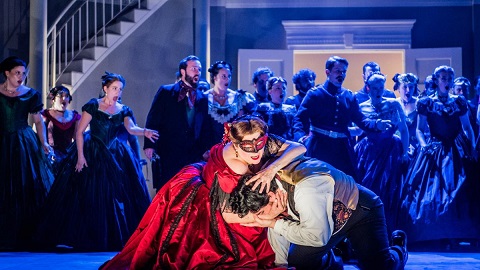 Claire Rutter (Amelia) and Vincenzo Costanzo (Riccardo). Photo credit: Robert Workman.
Claire Rutter (Amelia) and Vincenzo Costanzo (Riccardo). Photo credit: Robert Workman.
If the settings jar a little, musically it’s smooth sailing, thanks in no
small part to the superb playing of the Orchestra of English National Opera
– in residence for the season – under the assured guidance of conductor
Gianluca Marciano. Marciano wrings every ounce of drama from the score,
from the quietest motivic and coloristic gestures to the most terrifying
monumental climaxes, and he paces the drama discerningly; the dramatic
sweep from Amelia’s drawing of the name of the conspirator who will be
Riccardo’s assassin to the final tragic moments was compelling.
Some of the blocking of the Chorus feels a little stiff initially, and in
the first Act the principals, too, often stand and sing straight to the
house. However, the Grange Park Chorus were in final voice, both
collectively and when stepping forward as individuals: Trevor Bowes was
particularly fine as the drunken ‘sailor’, Silvano. The masked ball itself,
though, is persuasively choreographed: Plater uses the vivid lighting
design to ‘freeze’ the whirling dancers, creating a sense of an unstoppable
tragic momentum escalating beyond the flowing intimacy of the ballroom,
and, together with the richly coloured fabrics of the ladies’ ball-gowns,
this injects a vibrancy and tension that had previously been lacking at
times.
Claire Rutter’s dresses were rather ‘plain Jane’, but the soprano was in
gloriously lustrous voice, rising to the top with both ease and beauty in
Act 2’s ‘Ma dall’arido stelo divulsa’, as she foraged for the curative
herbs, and in ‘MorrÚ, ma prima in grazia’, when she pleaded for one last
chance to hold her son. Rutter persuasively responded to dramatic
situation, altering her tone, which was both pure and powerful,
accordingly. This Amelia out-sung her Riccardo, both in eloquence and
passion, but if Costanzo’s tenor was disappointingly tight initially, the
phrasing a little rigid and the intonation not always firm of focus,
Riccardo’s Act 3 vow to renounce his love and resume his stately duties to
his people, ‘Ma se m’Ë forza perderti’ had more conviction, both vocally
and psychologically.
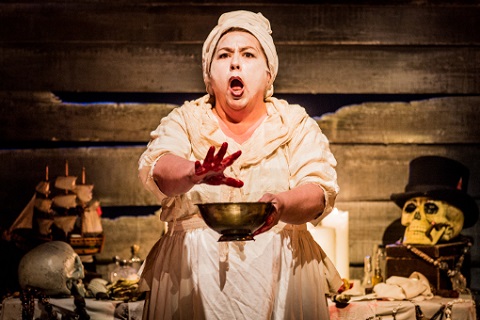 Elisabetta Fiorillo (Ulrica). Photo credit: Robert Workman.
Elisabetta Fiorillo (Ulrica). Photo credit: Robert Workman.
One problem was that there was little sense of romantic rapport between
Riccardo and Amelia, but if the lovers seemed somewhat detached, the male
bonding was heated with genuine passion and fire, thanks to a tremendous
performance by Roland Wood as Renato. The impulsive force of Renato’s
emotions was evident from the first, and as his rage was stoked by betrayal
and intrigue, so his menace grew ever more disturbing and fearsome. In Act
3, Renato’s ‘Eri tu che macchiavi quell’anima’ – in which he realises that
it is Riccardo and not his wife who should pay for his disloyalty and
decries the loss of his former paradise of love and friendship – held the
house spell-bound; Wood shaped every phrase with acumen and elegance, and,
his head fallen onto his desk in the agony of betrayal and grief, sustained
the final note with an impressive display of control and contour. The
baritone had massive reserves of power, and did not tire, if anything
growing stronger as the tragedy swept to its bitter conclusion.
Elisabetta Fiorillo’s employed a rather wide vibrato but was an ebony-toned
Ulrica and had the power to sustain the fortune-teller’s slow-paced
invocation, even as it plunged to the lowest depths. Bass-baritone Matthew
Buswell and bass Matthew Stiff were a convincing pair of assassins.
The role of Oscar was sung with punch and brightness by Tereza Gevorgyan,
but I found the soprano’s acting a bit heavy-handed: the ‘boys will be
boys’ back-slapping and bottle-swigging didn’t really ring true – but
perhaps the problem was that Oscar, dressed inexplicably as a cowboy, was a
mis-fit among the men of state.
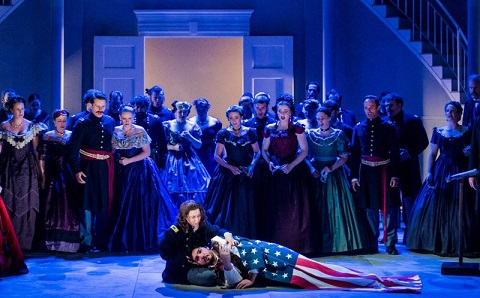 Tereza Gevorgyan (Oscar) and Vincenzo Costanzo (Riccardo). Photo credit: Robert Workman.
Tereza Gevorgyan (Oscar) and Vincenzo Costanzo (Riccardo). Photo credit: Robert Workman.
If Oscar seemed a little out of place amid the patricians of 19 th-century Boston, then he’d surely have felt at home on the
prairies of 1930s Oklahoma the following evening, where the triangular
frontier romances threatened to have similarly tragic outcomes but where
the sunshine eventually drove the storm clouds far away.
Jo Davies’ production of Rogers & Hammerstein’s 1943 hit, Oklahoma!, skilfully balances freedom and optimism with danger and
darkness, just as the streaks which pierce the pink sunrise which is lauded
by Dex Lee’s golden-toned Curly McLain in the show’s wonderful opening
paean to the land and the limitless opportunities of the frontier, ‘Oh,
What a Beautiful Mornin’’, hint at the evening thunder to come.
When the corrugated barn doors slide lethargically aside, designer Francis
O’Connor’s expansive rural vista invites us to cross the threshold and
journey to a different time, place and culture where, as the matriarchal
Aunt Eller commands, the ‘Territory folks’ should stick together –
“Cowboys, dance with the farmers’ daughters! Farmers, dance with the
ranchers’ gals” – but where community cohesion is threatened by individual
desire and will.
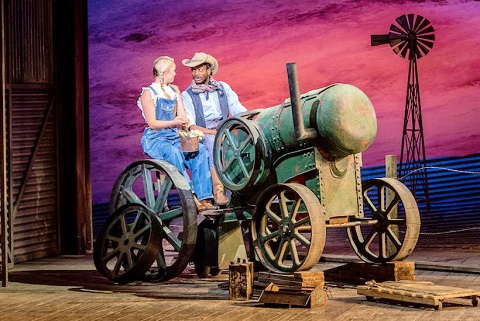 Katie Hall (Laurey) and Dex Lee (Curly). Photo credit: Robert Workman.
Katie Hall (Laurey) and Dex Lee (Curly). Photo credit: Robert Workman.
As the bright orange of dawn transmutes to the gentle grey of dusk, and the
indigo of night overpowers the cornflower blue of day, Bruno Poet’s
evocative lighting carries us through the slowly unfolding days. There’s an
assuring sense of unity, despite the surface tensions. A wind pump spins
lazily in the prairie breeze, a tree-sculpture of hoes etches a sharp
silhouette against the sunlit sky and Claire Moore’s Aunt Eller emerges
from beneath the steam engine she’s fixing, clutching a spanner and wiping
her oily hands on her denim dungarees – gestures which seem to symbolise
her disciplinarian role when cracks appear in the community.
The set and props are incorporated into the action with naturalism,
enhancing the realism and dramatic fluency. Hay bales serve as tables and
beds, ropes and hoes articulate the drama of the dances, the belching steam
engine metamorphoses into a bunting-bedecked wedding coach. Davies’ stage
direction, the set transitions and Andrew Wright’s choreography are equally
slick and accomplished – and share an impressive eye for telling detail.
As the farm workers hoist ropes and harnesses in the barn, we’re taken by
surprise when the boards are winched aloft to form the low, lowering
ceiling of Jud Fry’s rat-infested smoke-house. And, when the cow-girls who
arrange the scowling outcast’s hay-bale bed linger for a few moments, they
seem a teasing embodiment of the pornographic postcards which are tacked on
the walls, reminding us of the danger posed by Jud’s barely suppressed
sexuality – just as the kaleidoscope of ‘pitchers’ that he purchases from
the ‘Persian’ pedlar Ali Hakim is more than it seems: “Y’see it’s got a
little jigger onto it, and you tetch it and out springs a sharp blade.” No
wonder the wedding feast is disrupted by a downpour – a figurative deluge
of the destruction which springs from Jud’s isolation and pain.
 Louis Gaunt (Will Parker – centre) and Chorus. Photo credit: Robert Workman.
Louis Gaunt (Will Parker – centre) and Chorus. Photo credit: Robert Workman.
Wright’s dances have a beautiful balletic quality which emphasises the
essential fantasy of the dreams that these frontier folks indulge. This
climaxes in the end-of-Act 1 dream sequence, when the ‘The Elixir of Egypt’
which farmer Laurey Williams drinks – she’s purchased it from Ali who has
promied that it will help her to “see everything clear” – transports her
from twilight reflections to an ugly nightmare. The balletic grace of her
innocent fantasy of courtship and marriage with Curly contrasts
disconcertingly with the terrifying reality of Jud’s fearsome sexuality
which is explicitly represented by the vulgar sexuality of the seamy
can-can dancers. I can’t imagine this dream sequence better done.
The light amplification of the singing is not intrusive, and the cast wear
their cowboy boots and Stetsons with flair. As Curly, Dex Lee dances with
an easy muscularity which is matched by the beguiling warmth of his voice,
and it’s a real plus that there is such a strong and convincing romantic
frisson between Lee and Katie Hall’s Laurey – a tension which persuasively
sustains the dramatic development and resolution. Hall can do sweetness and
sulkiness with equal charm but, more than that, she uses her voice – which
expands at the top with a compelling bloom – to convey subtleties of
emotion and a sensibility and sensitivity which the communal unanimity is
designed to subdue.
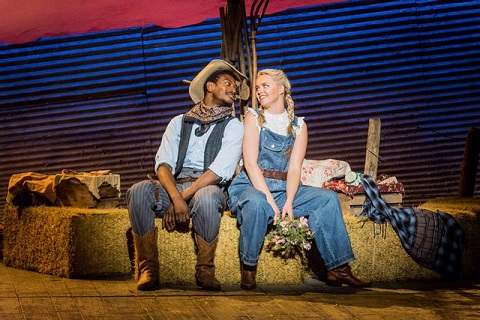 Dex Lee (Curly) and Katie Hall (Laurey). Photo credit: Robert Workman.
Dex Lee (Curly) and Katie Hall (Laurey). Photo credit: Robert Workman.
Louis Gaunt is delightful as the naÔve nincompoop, Will Parker, who woos
his beloved Ado Annie with optimistic, indestructible enthusiasm. When he
returns from Kansas City proudly and gleefully clutching the $50 which
will, he believes, win him his promised bride, the utopian dynamism of his
wondrous celebration – ‘ev’rythin’s up to date in Kansas City’ – sweeps all
around him into an intoxicating dance in homage to progress and the power
and potential of modern American.
At times the American accents border on hyperbole: I couldn’t count the
number of syllables that Natasha Cottriall managed to find in the “cain’t”
of her confession, ‘I Cain’t Say No’ – and in this number Cottriall forced
her voice a little too hard, occasionally at the expense of the pitch. But,
elsewhere this Ado Annie was not just enchantingly ditzy but also expressed
believable frustration at the choices before her, and her relationships
with Will, Ali and with her over-bearing but good-intentioned father,
Andrew Carnes – played with a brisk, no-nonsense presence by Nicolas
Colicos – were layered and real.
One of the musical highlights was Phillip Rhodes’s heart-touching rendition
of Jud Fry’s ‘Lonely Room’. Rhodes brooded stormily and captured all of
Jud’s menacing repression and injured soul. In this aria, his baritone
swelled with inner rage and suffering, descending darkly and with a powerful
focus which seemed to pin one to one’s seat, forcing one to reflect on the
perceived, and perhaps real, injustice and isolation which he suffers. This
was an ‘operatic’ soliloquy of gripping tragic depth.
Neither Steven Serlin as Ali Hakim nor Claire Moore as Aunt Eller indulged
in hammy caricature and the result was a compelling dramatic credibility.
Serlin, as he deftly transformed his suitcase into a table of wares,
slickly conveyed Ali’s flirtatious superficiality and his suave patter
seduced the ladies as quickly as it separated them from their dimes. Claire
Moore’s Aunt Eller kept order with the authoritative efficiency of both her
tongue and her rifle, and Moore’s convincing establishment of Eller’s role
as community leader made her command of the trial scene – a dramatically
awkward moment – more believable.
The big numbers all come in the first Act, and Act 2 can sometimes seem a
little wordy, but Davies kept things moving along through scenes such as
the auction, and the dances flowed seamlessly from the dialogue. The
fluency was greatly aided by the superb playing of the BBC Concert
Orchestra under conductor Richard Balcombe who achieved a terrific balance
between punchy pizzazz and delicate sentimentality, from the piping
birdsong which heralds the dawn to the barn-storming hoe-downs and
show-downs of the dramatic climaxes.
There is some inherent tension in Oklahoma! between the realism of
the theatrical tale and the escapism of the musical numbers – it’s
discomforting that Jud has to die so that wedding day celebrations can
reach their triumphant conclusion – and Davies did not fully resolve this
unease. But, if at the close she couldn’t quite overcome our questioning of
the rapid banishment of the threatening ‘other’ and the assimilation of all
within the larger community – as both Curly and the immigrant Ali declare,
‘We Know We Belong to the Land! – then perhaps we should simply remember
Aunt Eller’s pragmatism: ‘Well, le’s not break the law. Le’s just bend it a
little.’
Grange Park Opera’s 2018 festival continues
until 7th July.
Claire Seymour
Un ballo in maschera
Amelia – Claire Rutter, Riccardo – Vincenzo Costanzo, Ulrica – Elisabetta
Fiorillo, Renato – Roland Wood, Oscar – Tereza Gevorgyan, Sam – Matthew
Buswell, Tom – Matthew Stiff; Director – Stephen Medcalf, Conductor –
Gianluca Marciano, Designer: Jamie Vartan, Costume Designer – Nicky Shaw,
Lighting Designer – David Plater, Choreographer – Lynne Hockney, Orchestra
of English National Opera.
Grange Park Opera, West Horsley; Thursday 14th June 2018.
Oklahoma!
Curly – Dex Lee, Laurey – Katie Hall, Aunt Eller – Claire Moore, Will
Parker – Louis Gaunt, Ado Annie – Natasha Cottriall, Jud Fry – Phillip
Rhodes, Ali Hakim – Steven Serlin, Andrew Carnes – Nicolas Colicos, Gertie
Cummings – Lauren Hood, Ike Skidmore – Lee Ormsby, Kate – Natasha
Hoeberigs, Cord Elam – Dermot Canavan; Director – Jo Davies, Conductor –
Richard Balcombe, Choreographer – Andrew Wright, Set Design – Francis
O’Connor, Costume Designer – Gabrielle Dalton, Lighting Designer – Bruno
Poet, Sound Designer – Tom Marshall, BBC Concert Orchestra.
Grange Park Opera, West Horsley; Friday 15th June 2018.
image=http://www.operatoday.com/Wedding%20Scene%20Oklahoma%21.jpg
image_description=Grange Park Opera 2018
product=yes
product_title=Grange Park Opera 2018
product_by=A review by Claire Seymour
product_id=Above: Cast of Oklahoma!
Photo credit: Robert Workman